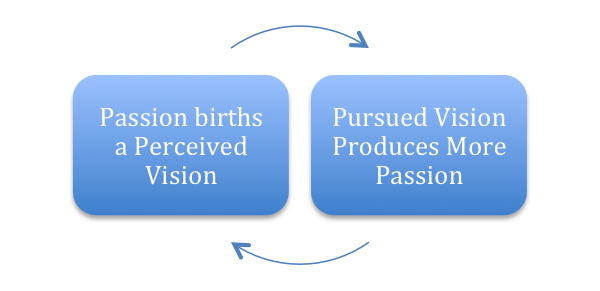Passion and vision are important parts of leadership and organizational culture. You have to capture a vision, and make sure the vision has substance. You have to discover your passion, and ensure it matches your vision. The truth is, neither can exist without the other. In fact, each one stimulates the other in what I call the passion/vision loop. Here’s how it works.
First, passion births a perceived vision. Vision doesn’t just pop out of nowhere. It begins when a leader’s hearts comes alive with passion. That passion is usually ignited when the leader is stirred by a need or a problem. Eventually the leader is able to articulate his passion as a clear and compelling vision for the future…something that becomes an answer to the need or a solution to the problem.
Second, pursued vision produces more passion. As the leader casts the vision, and mobilizes people and resources to pursue it, the passion grows even stronger. What the leader had always hoped for is no longer confined to wishful thinking. It’s actually happening, and the energy associated with progress becomes contagious. As Bill Hybels says, “Vision is a picture of the future that produces passion.”
As you experience the passion/vision loop, it’s good to keep three things mind to keep the loop alive without killing your organization.
1. Processes
In his book, Predictable Success, Les McKeown describes the stages organizations experience as they age. One stage is called “White Water.” Organizations experience White Water when their growth exceeds the capacity of the organization’s systems and processes. Things start to get choppy, break down, and fall through the cracks because old processes can’t support the new growth.
This condition can happen when the vision/passion loop picks up speed. The vision is executed to produce great results, and those great results create more passion to produce even better results. Instead of reaching 100 people, now you’re reaching 500. And if you can reach 500 people, surely you can reach 1,000 people. Instead of selling 1,000 widgets, now you’re selling 5,000 widgets. And if you can sell 5,000 widgets, surely you can sell 10,000 widgets. The problem is, your systems and processes can’t handle the growth. If the processes don’t match the growth, the growth will stop and the passion will fade.
2. Innovation
Failed processes aren’t the only danger in the passion/vision loop. On the other end of the spectrum is innovation. If leaders aren’t careful, their passion can drive them to fall in love with a product, rather than an outcome. When you fall in love with a product or a service, you just keep creating or doing more of it, even when it no longer works. You love it so much that you think everyone else should love it too. And at first, they do.
[bctt tweet=”Don’t let your passion drive you to fall in love with a product rather than an outcome. “]
But if you never update the product, if you never improve the program, if you never refine the service, if you never introduce something completely new, eventually you’ll be out of business. When your passion is connected to outcomes (meeting needs and solving problems), you’ll continually innovate the best solutions. But when your passion shifts to the product or service itself, rather than the desired outcome, you run the risk of being the next VHS tape or rotary phone.
3. Discipline
There’s one final danger in the vision/passion loop. As the passion grows and expands, so can your vision for the future. The possibilities begin to multiply like rabbits, and you can innovate to the moon and back with a real desire to produce life-changing outcomes.
This can seem good on the surface, but it can also lead to what Jim Collins calls “overreaching.” Overreaching happens when organizations – enamored by their success – fall prey to an undisciplined pursuit of more. Their success leads to pride, and their pride makes them think they can do anything. A loss of focus leads to a loss of discipline. As the loop picks up speed, it’s essential that disciplined leaders create a disciplined organization. You ultimately have to learn how to differentiate between an opportunity and a distraction.
Processes, Innovation, and Discipline can actually co-exist. The right processes should make things run smoother, not become a set of bureaucratic handcuffs. Keep the processes simple and practical. Author Nelson Searcy says a S.Y.S.T.E.M Saves You Stress, Time, Energy, and Money. Innovation is most often tied to the people on your team. Make sure they have permission to create, innovate, and try new ideas. If innovation is frowned up, eventually the innovative people will leave the organization. Finally, be disciplined about the things that matter most. Watch expenditures, hire slow, and don’t shortcut your systems.







